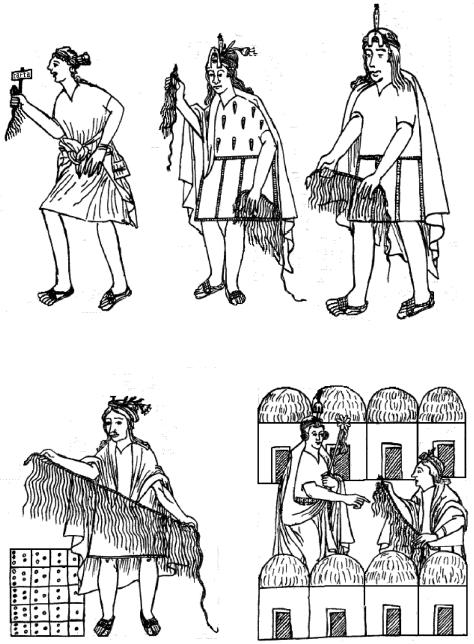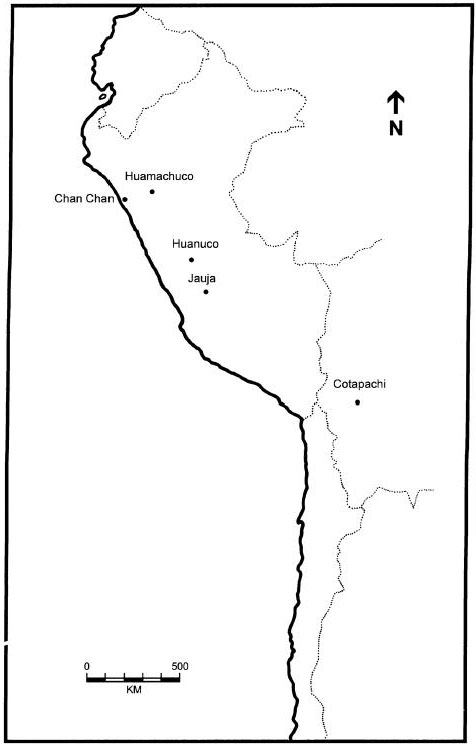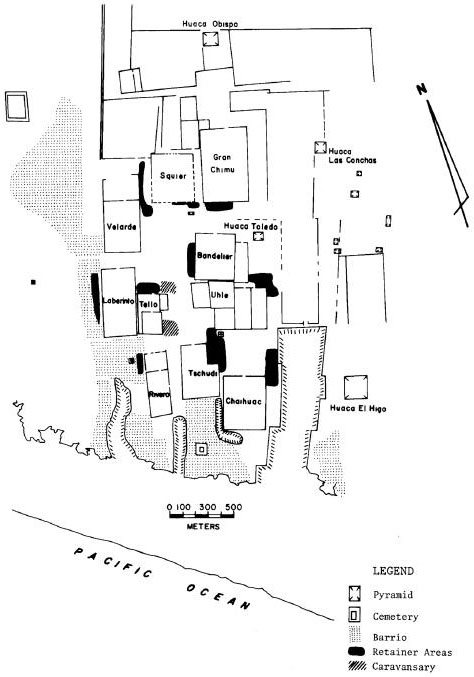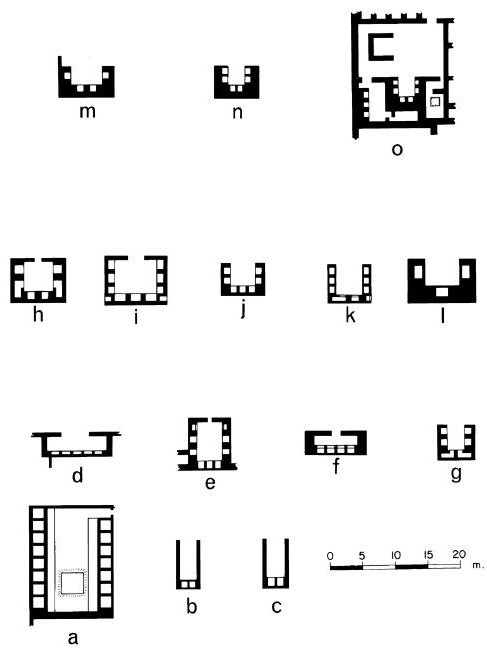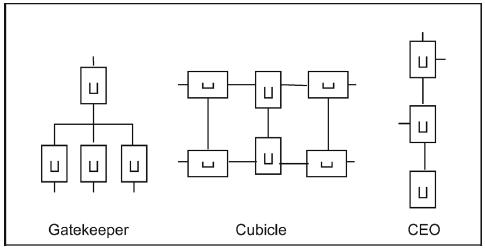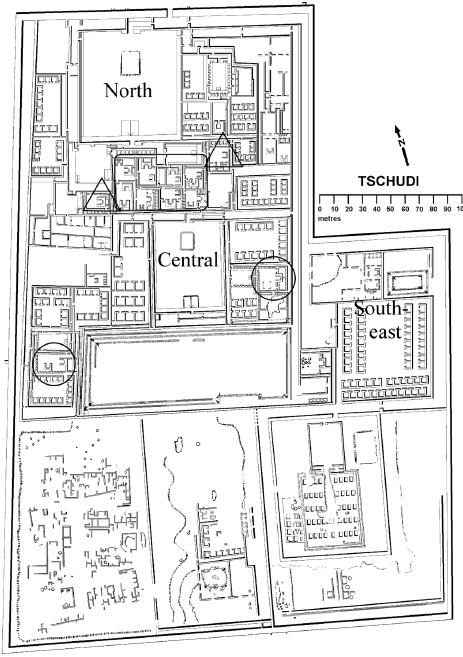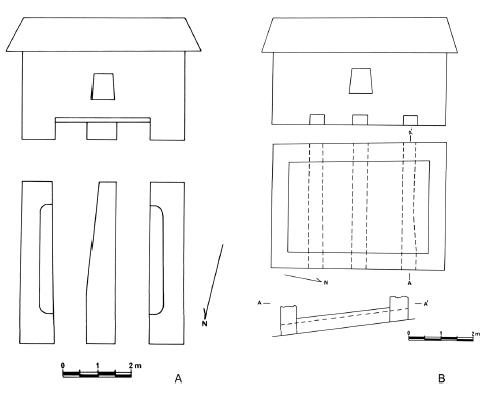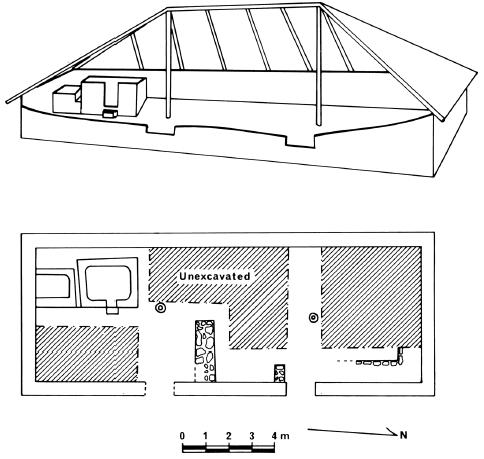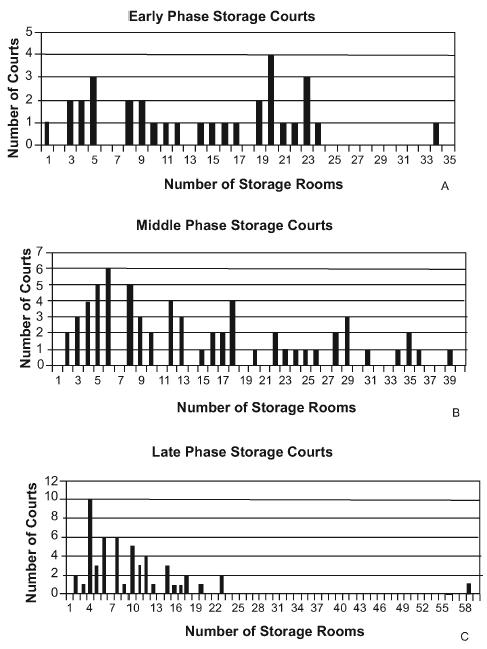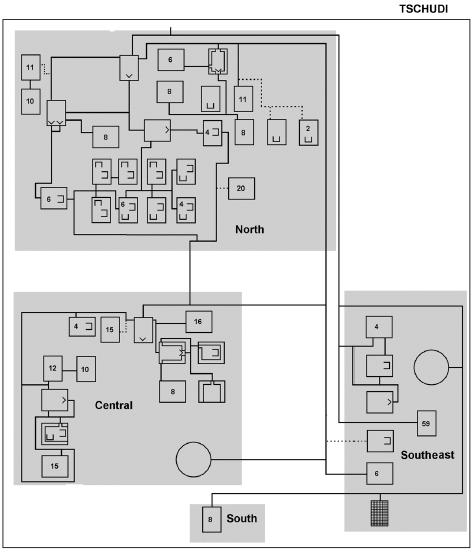CHAPTER SIX
STOREROOMS, TOKENS, AND ADMINISTRATIVE DEVICES: AN ANDEAN CASE STUDY
John R. Topic
Introduction
Over the past few years, one of my interests has been focused on how information recording systems developed in the Andes. In other areas of the world, information-recording systems are usually based on words in some way or another. This does not seem to be the case in the Andes, where the ability to actually record texts in any formal fashion is something that has never been conclusively demonstrated. But Andean people did develop very sophisticated data-recording systems.
These Andean data-recording systems generally emphasized the recording of numerical information, with nonnumerical qualifiers that provided context for what the numbers represented. It is this combination of numbers and qualifiers that I focus on in this chapter. The recording of numbers is relatively straightforward, but how Andean people recorded the qualifiers is more variable and interesting.
I first provide some background information on the quipu, the record-keeping device used by the Inkas. I then describe an earlier device used by the Chimú (ca. AD 850–1470) that was based on a specific form of architecture combined with the use of tokens for recording information. The Chimú device is closely associated with large numbers of storage complexes. As Rothman (Chapter 1) points out, storage can be considered a useful marker for comparing cultures at different times and scales. I explore how the arrangements of storage complexes among the Inka and the Chimú contributed to the recording of information about the materials stored and possibly also reflect aspects of community, economic, and political organization.
Background
The best-known Andean record-keeping device is the quipu (Ascher and Ascher 1981; Locke 1923; Mackey 1970; Mackey et al. 1990; Radicati di Primeglio 1979; Urton 2001). Quipu are record-keeping devices made of strings or yarns, usually with a long header string to which knotted pendent strings are attached (Figure 6.1).
The quipu could record numbers, but it is a mnemonic device (a memory aid); hence, like other New World recording methods, it was not designed to precisely record speech (Boone 1994; Mignolo 1994: 229). The quipucamayoc (official who kept and read the quipu) needed to remember what each string signified, but if he knew what the string signified he could read the numbers off it readily. The numbers were recorded by different kinds of knots and the order of magnitude (one, ten, one hundred, one thousand, and so on) was indicated by the location of the knot on the string (Cieza de León 1985 [1553]: 330; Garcilaso de la Vega 1966 [1609 and 1617]: 330).
The basic structural characteristics of the quipu, then, consist of numeric values recorded in a particular position on a string and those positions have predefined values. The basic structure of the quipu informational system was augmented by a few other characteristics. First, a number of strings could be combined into a single larger quipu in order to record different categories of things within a single quipu record (see Figure 6.1). To facilitate remembering the different categories represented by each string, they were sometimes coded by color, the direction the string had been spun, the thickness of the string, and so forth. (Calancha 1974–82 [1638]: 203–206; Garcilaso de la Vega 1966 [1609 and 1617]; Mackey 1970: chaps. 2 and 6). Tus, nonnumeric qualifiers provide the context for understanding the recorded numeric values.
Moreover, at least by late Inka times, the categories recorded on a series of strings within a quipu were organized in a standard order based on the relative importance of the items (Calancha 1974–82 [1638]: 204–205; Garcilaso de la Vega 1966 [1609 and 1617]: 330; Mackey 1970; Murra 1975, 1982). This correlation of cognitive ranking with the sequential ordering of the strings again emphasizes the structural importance of the place or position, with predefined value, in which numbers are recorded. However, the significance of the positions and qualifiers has to be learned and communicated from one bureaucrat to another; they are not inherent in the sense that an S-spun brown cotton string, in the third position on a larger quipu, will always record information about the same category of thing.
Quipu were in use as early as AD 700 in the Central Andes but the early quipu are quite different from the quipu generally associated with the Inka. The most striking characteristic of the early quipus is that the primary pendant cords are wrapped with yarn, usually at the top of the pendent near the transverse cord (Conklin 1982; Pereyra-Sánchez 1997; Radicati di Primeglio 1990). These “wrapped quipu” or quipu de canutos also usually use only simple knots (for exceptions, cf. Pereyra-Sánchez 1997: 194; Radicati di Primeglio 1990: 45), rather than the combination of simple and long knots normally used on Inka quipu. Moreover, knots occur on only some of the pendent cords; the published descriptions suggest that the number of knots on any cord is not very large, perhaps never exceeding ten. The one example analyzed in detail by Conklin (1982) seems to employ a combination of binary, base 5, and decimal numeric systems on different strings. Hugo Peyrera (1997: 196) notes that pre-Inka quipu lack the positional values for the knots on the pendant cords corresponding to units, tens, hundreds, and so on.
The context in which these early quipus were used is not known nor is it clear what kinds of information might have been encoded on them. Conklin (1982) suggests that the nature of the information recorded may have been astronomical or ritual; Radicati di Primeglio (1990: 46–48) suggests that the colors of the wrappings might represent the elements (water, fire, earth, metal, and wood) or personal names. These suggestions have little evidence to support them, but it is clear that the investigators who have worked on the early quipu consider their structure to be distinct from the better-known Inka quipu and the early quipu may have been used for different purposes than Inka quipu were. Conklin (1982) notes that the Inka quipu was the result of a long process of development. Unfortunately, however, since the pre-Inka quipu are mostly not provenienced or dated, the process of development cannot be traced in any detail.
On the other hand, it is clear that there was a certain amount of standardization among Inka quipu. For example, two basic kinds of quipu have been recognized: quantitative quipu, in which the numbers on different strings can be shown to be related to each other arithmetically (e.g., one string sums others), and quipu in which the numbers on the strings seem to serve as labels, rather than as arithmetic quantities (Ascher 1990). The knots themselves are standardized, so that there are usually only three different kinds of knots used and these are used preferentially to denote the units or the higher numbers. Moreover, sequences of color combinations recur frequently within a single quipu or within associated lots of quipu, demonstrating another form of standardization, at least within the quipu used by a single quipucamayoc (Mackey 1970: 76–77). It is these types of standardizations and patterns in the quipu that allow even modern researchers to be able to read the numbers and have a sense of the structure of the ancient quipu.
Other aspects of Andean record keeping were methods of gathering data and performing calculations. The Andean abacus, or yupana, illustrated by Guaman Poma (Poma de Ayala 1980 [1615]: 360) (see Figure 6.1)) is interesting, because it is again based on the principle of representing numeric values in particular places or positions where those places have predefined values. Guaman Pomâs drawing shows a simple array of cells, consisting of five rows and four columns; the array of cells could simply be marked on the ground by drawing some lines in the dirt, drawn on a piece of cloth, or perhaps carved in wood or stone. Although there is some debate about exactly how the abacus functioned, it is clear that each cell had a numerical value and calculations were performed by moving tokens—a stone, bean, maize kernel, quinoa seed, and so on—from one cell to another; early historical accounts indicate that they could perform calculations from one to 100,000 (Acosta 1940 [1590]: 290–292; Poma de Ayala 1980 [1615]: 360[362]–361 [363]; Pereyra-Sánchez 1990; Wassén 1990).
Modern Andean peasants still keep track of herds and harvests by using simple counting and recording techniques. Potatoes and maize are counted in groups of ten, with one potato or ear set aside for each group; then the tens are counted in the same manner, setting aside one potato or ear to represent a hundred, until a final figure is arrived at and recorded on a quipu (Núñez del Prado 1990). Larco Hoyle (1942: 100–101; 1943: 352) reported that beans of different types and colors are used to represent animals in a herd or the warps in a textile; again, the tokens (beans in this case) used by individual herders and weavers could later be recorded on quipu. However, in the first instance, the recording is easier to accomplish by using a physical object as a counter. Thus, for example, a herder counting sheep being herded into a corral might drop a stone (a token) into one pile for every female and into another for every male. The piles for males and females— places with predefined values—serve as nonnumerical qualifiers.
On the other hand, sometimes the qualifier is actually the thing that is being counted: Larco Hoyle (2001: 1:163), for example, gives ethnographic examples of grains of maize and beans representing multiples of themselves. Crops, like beans and maize, can be recorded using the corresponding kernels to represent sacks of produce. The maize kernels or the beans serve as tokens to represent larger quantities of the same commodity. On the other hand, beans, and other tokens, can easily represent commodities other than themselves. Again, Larco Hoyle (2001) gives an example where sheep can be represented by chochos (a lupine bean) and cows by ñuñas (a variety of common bean).
There are also examples of images used as qualifiers. One of the best examples is discussed by Margaret Jackson (2002), where scratched rudimentary images on the outside of ceramic molds indicate the design formed by the mold. On a similar line, we can point to the images (hands, feet, and so on) used as maker’s marks on Moche bricks (Moseley 1975b) and the incisions used as maker’s marks on some ceramics (Donnan 1971; Topic and Moseley 1985), or the possible use of cylinder seals (Pozorski and Pozorski, Chapter 5, this volume).
Spatial Patterning as Information
One of the qualifiers, already mentioned with regard to both the quipu and the yupana, is the spatial dimension of place, location, or position. We are familiar with the value of place, and placeholders, in our own numerical system. This is paralleled in the positioning of knots in the quipu or the manipulation of tokens among the cells of the yupana. The placement of objects in space is one way to record information.
Figure 6.2 Sites discussed in this chapter. After Snead (1992).
Chimú Administrative Devices
In a previous article (Topic 2003), I argued that the earliest recognizable bureaucracy in the Andes developed at Chan Chan, the capital of the Chimú Kingdom (Figures 6.2 and 6.3). Chan Chan was probably first occupied about AD 850 and was conquered by the Inka about AD 1470. I am using the term bureaucracy in the Weberian sense of a form of administration in which fixed areas of jurisdiction are ordered by rules and regulations, resulting in a stable distribution of authority across a group of officials who are employed in their offices, because they have the requisite qualifications to fulfill their duties (Weber 1946: 232–239). The bureaucracy forms an administrative interface between the rulers and the ruled that acts as an agency of control, largely by controlling sources of information and communication.
The development of bureaucracy at Chan Chan can be traced archaeologically by examining the morphology and distribution of a special type of building referred to as an audiencia or U-shaped structure. These structures occur at a variety of Chimú sites, but they are especially common at Chan Chan, where they are concentrated in the palaces, which also housed large-scale storage. Most Chimú scholars have long believed that the audiencias were associated with the control or administration of storage, although Jerry Moore (1992) argued that the audiencias do not control access to the storage facilities either physically or by line of sight. My analysis (Topic 2003) examined the morphology and distribution of the audiencias chronologically. The analysis showed that during the early occupation at Chan Chan the audiencias were closely associated with storerooms and that the occupants of the audiencias would have functioned like stewards in close contact with the physical commodities for which they were responsible; during the late occupation at Chan Chan, however, the distribution and morphology of the audiencias had changed and their occupants now functioned as bureaucrats, controlling information about commodities that were spatially isolated from the audiencias.
The term audiencia is used here in a generic sense to encompass a set of structures, with varying characteristics, that include types referred to as audiencia variants, arcones, trocaderos, and tablados (Andrews 1974). These types of structures frequently have just three walls and are open on the fourth side, like a block letter U; sometimes, however, their layout is more like a block letter C (Figure 6.4). The interior floor of the audiencia is usually raised a bit above the floor of the surrounding court. Audiencias usually have a varying number of bins, troughs, or niches in their walls.
I hypothesized that the bins, niches, and troughs might have the same sort of predefined place value that we see in the strings of the quipu or the cells of the yupanas (Topic 2003: 245–251). In a manner similar to the yupana, pebbles or beans or other tokens could be placed in the niches, bins, and troughs to record quantitative information. A bin or niche could represent a commodity in storage, or a commodity that was due to be delivered, or one that was due to be shipped out for some reason. Niches could have been subdivided, using cloth bags, ceramic bowls, or gourds, to add categories or subcategories much like the pendent strings on a quipu.
Figure 6.3 Basic plan of Chan Chan at the time of the Inka conquest (Topic and Moseley 1985).
The validity of the analogy between the audiencias and quipu cannot be tested directly, but it can be shown that the analogy makes sense within a larger interpretation of the changing morphology and spatial distribution of the audiencias. The article presented four independent arguments to support the analogy (Topic 2003: 252–268).
The first argument had to do with the need for standardization in the way that information was being recorded and stored. A bureaucracy with officials of fixed jurisdiction, controlling information, needs to share that information, or some of that information, between jurisdictions. To use a modern analogy, everyone should be using the same operating system. In the case of Chan Chan, if the form of the audiencias—the number and arrangement of niches, for example—is part of the operating system, then these have to become standardized as bureaucracy develops, and that is exactly what we see at Chan Chan. The early phase is characterized by a wide variety of audiencias, as Figure 6.4 illustrates. There is a reduction in variation during the middle phase, and a high degree of standardization is evident in the late phase. In the late phase a single form with six niches dominates (Figure 6.4n). The patterning in the early phase is consistent with officials who are acting like stewards, idiosyncratically encoding information about the commodities entrusted to them. The audiencias in the late phase are consistent with a system in which bureaucrats are archiving information in a manner that is potentially readable by other bureaucrats. As noted above for the quipu, some degree of standardization is a precondition for the development of an information-recording system that can support a bureaucratic administration.
The documentation for the second argument is much more complicated (Topic 2003: 253–262). However, the essence of the argument is relatively straightforward: stewards will be in close association with storerooms while bureaucrats do not need to be as closely associated with the commodities they are administering, because they are really administering information about the commodities rather than the commodities themselves. The physical evidence of this shift is the increasing isolation of the administrative structures, the audiencias, from the storage complexes that they are administering. Moreover, through time the audiencias become increasingly associated with other audiencias, occurring in clusters that are physically isolated from the storage facilities. The clustering would facilitate communication between the officials occupying the audiencias; indeed, the implication is that late in the sequence officials are more concerned with exchanging information among themselves about the commodities stored than they are with physically monitoring the storage facilities.
The distancing of the audiencias from the storerooms is associated with an increasingly hierarchical arrangement of audiencias. The spatial distribution of the structures can be used to demonstrate these hierarchical relationships. I discussed three different spatial patterns that are related to increasing hierarchical relationships between the occupants of the audiencias (Topic 2003: 262–266) (Figure 6.5). One was the “CEO pattern,” in which several layers of lower-ranking officials protected access to their superior; a second was the “gatekeeper pattern,” in which one official controlled access to several other officials; and a third was the “cubical pattern,” in which a cluster of officials were apparently functioning as equals, but under the control of either a CEO or gatekeeper.
Finally, I argue that the spatial distribution of audiencias suggested a sophisticated rationalization of the bureaucracy during the final occupation of the site. Palaces were divided into functional sectors (Figure 6.6); the ratio of audiencias to storerooms was higher in the northern sectors of the palaces and lower in the central sectors of the palaces; and all three patterns of hierarchical organization were represented. This level of rationalization is only present in the last two palaces, which date to the period just before the Inka conquest (ca. AD 1425 to about AD 1470). This late pattern of audiencia distribution indicates a complexly organized set of officials with different jurisdictions, whose major function is the control of information.
Trough time, then, a number of trends can be traced that indicate the formation of a bureaucratic form of administration in the palaces at Chan Chan, each one of which served for a time as the center of the Chimu administration before it was replaced by a later palace. These trends include the following: (1) standardization of the audiencias, indicating a standardization of accounting procedures; (2) an increasing spatial separation between the officials in charge of goods in the storage facilities and the goods themselves; (3) an increasing hierarchical organization; and (4) a reorganization or rationalization of the distribution of audiencias.
So the location of the U-shaped structures vis-a-vis the storage rooms provides us with information about the changing protocols: from the direct responsibility of one U-shaped structure for the specific recording of information about a particular storage court or group of courts, to the hierarchical organization of records about all storerooms that are shared or compartmentalized among a group of U-shaped structures.
The Distribution of Inka Storerooms
I return to the discussion of Chimú storerooms below, but first I want to briefiy discuss a few cases of Inka storeroom distribution. Inka storage is justifiably famous (for an early classic study, see Morris 1967), and its scale is far beyond the scale of storage present at Chan Chan, in terms of both storage capacity and regional distribution. While the Inka quipu recorded many different types of information, one of those types of information concerned the materials in the storerooms (see Figure 6.1). Indeed, several scholars have considered the storerooms themselves to have been an integral part of the accounting system (D’Altroy and Earle 1992; D’Altroy and Earle 1992; LeVine 1992a; Morris 1967, 1992b, 1992c; Topic and Chiswell 1992).
Earle (1992: 339–340) summarizes this view of Inka storage structures as “units of accounting,” citing two main observations: first, that the storage units have a consistent size and, second, that the storage units are arranged in sites or in rows in which only circular or rectangular buildings occur. While neither of these points is entirely accurate, they do provide a place to start to examine storage as an accounting device.
When we think of Inka storage, the picture that most frequently comes to mind is probably Huánuco Pampa, with its array of storerooms in rows stretching along a hillslope overlooking the site. A standard interpretation is that the hillslope was probably chosen to catch the breezes, the colder air at night and the drying rays of the sun during the day (LeVine 1992b: 3–5). Moreover, the storerooms were designed and built with special features that would facilitate the active manipulation of temperature, humidity, and air circulation (Morris 1992c). In total there are 497 storerooms and twenty-five nonstorage structures arranged in eleven rows going up the hillslope (Morris 1992b). There are both round and rectangular structures; the round structures (278) predominate and vary in diameter from 2.0 to 6.3 meters. Morris (1992b: 157) notes that there are four modal diameters: 2.7, 3.3, 4.3, and 5 meters; similarly, the rectangular rooms varied in width from 2.5 to 3.4 meters and in length from 3 to 10 meters (Morris 1992c: 237). The first two rows are a mixture of round and rectangular storerooms; rows 3–7 have only round storerooms and rows 8–11, on the upper slope, have only rectangular storerooms.
On the basis of his excavations, Morris proposed that the circular structures usually were devoted to maize storage and the rectangular structures were usually devoted to tuber storage (Morris 1992b, 1992c). Morris (1967) felt that the differently shaped storerooms would help with accounting for the goods within the storerooms. However, there was at least one case where maize and potatoes were stored in the same circular room (Morris 1992b: 162; 1992c: 246). fiis case is in row 2, where there were two small circular storerooms flanking a rectangular room; Morris (1992b: 162; 1992c: 246) interpreted these rooms as storage for a small religious shrine. He also (Morris 1992b: 160–161) hypothesized that the mixture of room shapes in rows 1 and 2 might be related to short-term storage and that prestorage processing and packing may have taken place in this area. He (1992c) notes that maize was stored as kernels in large jars, while potatoes were stored wrapped in bales of straw.
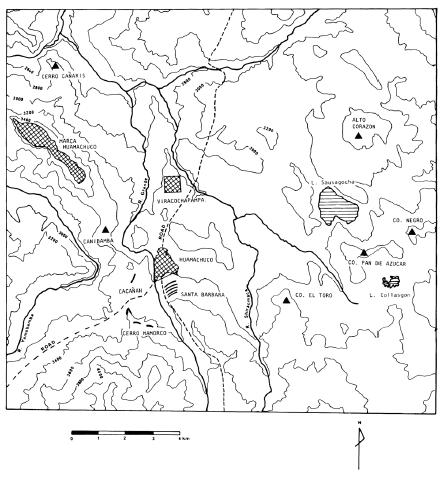
While Huánuco is an “artificial” city, built high on the cold grasslands thirty-eight hundred meters above sea level, Huamachuco was an Inka administrative center built in a well-populated and fertile area just below thirty-two hundred meters in elevation. Morris (1992c: 238) has noted that Inka storerooms were always in groups and aligned in orderly rows. In Huamachuco, the storerooms are arranged in five separate groups on three different hillslopes surrounding the center (Topic and Chiswell 1992) (Figure 6.7). All the storerooms are rectangular, but the different flooring, drainage, and ventilation features indicate a range of functions. While each group tends to have rooms similar in size, there are differences in size not only between the groups but also within the groups (Topic and Chiswell 1992).
Our excavations identified three types of storerooms. One type of storeroom is built on piers in order to allow ventilation below the floor (Figure 6.8A); macro-botanical remains indicate that these were used for maize and probably other items demanding very dry conditions. Another type of storeroom had canals embedded into the floor, which would be useful both for drainage and for introducing higher humidity into the room (Topic and Chiswell 1992) (Figure 6.8 this volume). Morris (1992c: 251–257) has noted similar canals at Huánuco Pampa and suggested that the introduction of water into the subfloor would be useful for tuber storage by facilitating cooling and increasing humidity. Phytolith evidence indicated that two of the four excavated storerooms with canals had contained large quantities of Stipa ichu, a grass that may have been used as packing for bales of potatoes. One excavated storeroom was not elevated nor did it have canals, so it may have been more of a multipurpose structure. In this storeroom we found fragments of burned plaster, suggesting wattle and daub compartments within the structure, Stipa ichu phytoliths, and some carbonized maize. So, although all the storerooms in Huamachuco are rectangular, we have evidence there for specialized maize storage, specialized tuber storage, and for storage of a mixture of items in a single storeroom, just as Morris found for Huánuco.
Much as at Huánuco Pampa, there is a pattern to the grouping of storerooms. On one hill, Cerro Santa Bárbara, we estimate that there were about 125 storerooms for maize. These are located just above some agricultural terraces and we (Topic and Chiswell 1992: 231) consider the terraces, and storage complex to be related to production for the state, the religious institutions, or the Inka elite. Sherds of large storage jars are absent, so that the maize was probably stored in sacks rather than in jars.
The estimated twenty-six storerooms on Cerro Cacañán are associated with eight larger buildings that may have been used for administrative purposes, including prestorage sorting, measuring, and packaging (Topic and Chiswell 1992: 211, 221). The two excavated storerooms in this group both had sub-floor canals and were probably used for tuber storage. We excavated one of the nearby larger buildings (Figure 6.8b), which had two binlike rooms in one corner, which might have been used for measuring goods before they were packaged and put into storage (Topic and Chiswell 1992: 221). The association of administrative facilities with tuber storage suggests that this complex was the complement to the complex on Cerro Santa Bárbara and that it was also closely associated with state or elite functions.
On Cerro Mamorco there were three separate groupings of storerooms. These are made up (from the south) of a row of nineteen rooms, then a row of fifteen rooms, and then a V-shaped row of up to thirty rooms. We excavated three of the rooms in this last group. Two of the excavated rooms had canals and Stipa ichu phytoliths, suggesting tuber storage, and the third was the room with evidence for mixed storage. The evidence for mixed storage here, as well as the fact that the complex was divided into three distinct groupings, suggests that these storerooms may have been devoted to some special purpose or group, such as the local community, a shrine, or other institution (Topic and Chiswell 1992: 231).
In Huamachuco, then, we see the groupings of storerooms to be more significant than size or shape. However, the details of storeroom architecture certainly do suggest what might have been stored in each building. Returning to the theme of accounting devices, the architecture of the storerooms may have determined what commodity was best stored in each place; the location of the place, in terms of the five clusters, may have been related to the source and/or destination of the goods stored. Again, position, place, or location seems to be part of the accounting system. The units of accounting may be listed in descending spatial order as the hillslope, the group, the storeroom (in some cases on Cerro Mamorco), the compartment, and then either the sack or bale.
When we turn to the Jauja area, the distribution of storerooms still clusters in groups, but those groups are much more dispersed around the major centers than in Huamachuco. There seem to be more than three thousand storerooms distributed across fifty-three sites in the general area of Jauja (D’Altroy and Earle 1992: 184; D’Altroy and Earle 1992: 262), but only 1,992, in thirty different sites, were located within the survey area of the Upper Mantaro Archaeological Research Project (D’Altroy and Earle 1992: 184). These sites were located as far as seventeen kilometers from the center at Hatun Xauxa. As at Huánuco Pampa, there were both circular and rectangular storerooms. However, based on a very small sample (six) of excavated structures, D’Altroy and Hastorf (1992) show that the botanical remains do not conform to Morris’s suggestion that circular structures were primarily for maize storage while rectangular structures were for tuber storage.
While they have recognized that the storerooms vary in size (D’Altroy and Earle 1992: 184–189; D’Altroy and Earle 1992: 262) the Upper Man-taro project emphasized the standardized size of the structures as one of the principal accounting features (D’Altroy and Earle 1992: 201; D’Altroy and Earle 1992: 262; Earle 1992: 339), and, thus, they tended to measure storage in estimated volumes rather than in storeroom units (D’Altroy and Earle 1992: 184ff., table 6.3). They note that coeficients of variation for length and width of storerooms within each site were between 5 percent and 10 percent (D’Altroy and Earle 1992: 199–201), although variation between sites might be larger.
They viewed the shape of storerooms as reflecting state policy rather than goods stored. They note that the predominance of rectangular storerooms on the eastern side of the valley (303 of 417) correlates with a lack of population in a very fertile area; they interpret this as an indication that there were state-controlled farms in this area and that the produce was stored predominantly in rectangular storehouses and used to support direct state activities (D’Altroy and Earle 1992: 199ff.). In contrast, the predominance of circular storerooms on the western side of the valley (281 of 407) is associated with local population centers (D’Altroy and Earle 1992: 199ff.) and hence the financing of state activities within the local communities. The largest storage complexes adjacent to the main administrative center had a similar mixture of circular and rectangular units, such that site J-17 had a predominance of circular structures (415 of 479), while the combined sites of J-15 and J-16 had a predominance of rectangular structures (305 of 452) (D’Altroy and Earle 1992: 193–194). Still, the data show only the predominance of one shape over the other, not absolute segregation into singular types. As Earle (1992: 340) notes, the meaning of these patterns is somewhat elusive.
I would emphasize the overall distribution of storerooms more than the shape or the size of the rooms. The location and grouping of storerooms into clusters, and the dispersal of the clusters of storerooms throughout the Jauja area carry information. In contrast to Jauja, the storerooms at Huamachuco and Huánuco were all located on hillslopes overlooking the administrative center. As in Huamachuco, and in contrast to Huánuco, the Upper Mantaro valley was well populated before the arrival of the Inkas so that the division of storage into multiple sites, the association of some storage sites with residential sites of the local population in the western part of the valley, and the provision of mixed types of storage might be similar to what we observed on Cerro Mamorco. What we gloss as “Inka storage” is better understood, in these cases, as a complex system serving community, ritual, and state needs (see Rothman, Chapter 1, this volume).
Finally, there is the interesting case of Cotapachi, Bolivia. Geraldine Byrne de Caballero has published brief newspaper articles about this important site (Byrne de Caballero 1973, 1975; see also Snead 1992). According to her description, which may be idealized, the site consists of two groups of twelve hundred storerooms arranged in just two clusters. The storerooms in each cluster are perfectly aligned in a grid. All the storerooms are round and three meters in diameter. Only the foundations are present, but these are of cut stone; the superstructure must have been of adobe, probably with a conical thatched roof.
Even if the description is idealized, here there clearly is a concentration of structures of a singular form and consistent size. Many scholars associate the storage complex at Cotapachi with the state maize fields in Cochabamba (e.g., Morris 1992a: xii; Snead 1992: 76–77, 92). The Inka emperor Huayna Capac had established these very large fields and organized their production for the support of his armies (Wachtel 1982). Indeed, this is the best documented agricultural complex that was devoted to production for the state, rather than to production for individual members of the elite.
Cotapachi, then, may have been a storage center for maize from the state farm in Cochabamba before it was trans-shipped to other destinations, such as Cuzco. Notably, the number of storerooms in Jauja and in Cotapachi is on the same order of magnitude, but the distribution is very different. Again, the implication is that there is specific information embedded in the distinct distributions. Whatever the dispersed pattern of storerooms in Jauja might represent, the Cotapachi storerooms are clearly structured in a much more formal and concentrated pattern. One possibility is that Cotapachi might reflect moiety structure at the state level.
These four cases suggest that the arrangement of storerooms in groups was at least as important to the Inka as the size or shape of the storerooms themselves.
Storage at Chan Chan
At Chan Chan, the shape of storerooms is relatively consistent in the sense that all are square or rectangular in shape. Storerooms are grouped into storage courts and within a court storerooms are often similar in size. The storerooms themselves are built of adobe bricks and have raised thresholds, probably to help keep out rats and mice (Day 1982a, 1982b). Other than the raised thresholds, the storerooms lack the sophisticated temperature and humidity control features of their Inka counterparts.
Since all the storerooms were systematically cleaned out at the time the site was abandoned, we have little evidence for what might have been stored in them or how the materials stored had been packaged. Textile impressions on the floors of some rooms (Day, personal communication) may indicate that either textiles were stored or that other goods were stored in cloth bags. In previous articles I have argued that a major function of the storage at Chan Chan was to provision thousands of artisans, primarily metalworkers and weavers, who lived within the city, as well as to collect and redistribute their products (Topic 1990, 2003, 2009).
In terms of exploring the distribution of storerooms as part of the accounting system, I am here interested especially in how the storerooms are distributed within the palaces. I have looked at a sample of the numbers of storerooms in the storage courts at Chan Chan (Figure 6.9; see also the Appendix 6.1). Because some palaces are poorly preserved, I have drawn this sample of storage courts from the same palaces that I used in my previous article (Topic 2003). The numbers of storerooms per storage court are based on the Chan Chan maps (Moseley and Mackey 1974); those maps were drawn, in the first instance, on the basis of air photographs, followed up with field checking and some test excavations (Moseley and Mackey 1974). The sample consists of 2,025 storerooms arranged in 156 storage courts.
The fact that the storerooms are arranged in clusters in storage courts probably does indicate that the clustering is part of the accounting system. From that point of view, it is of interest that 60 percent of the storage courts in this sample have twelve or fewer storerooms in them and 90 percent of the courts have twenty-four or fewer storerooms in them. On the other side of the equation, 74 percent of all storerooms occur in courts containing twenty-four or fewer storerooms. Yet there is a long tail to this distribution, so that we do have one example of a storage court with fifty-nine storerooms (see Figure 6.10).
These distributions are more like Huamachuco or Jauja than Huánuco or Cotapachi. The variation in the numbers of storerooms in different courts suggests, perhaps, either that different commodities were stored in different quantities (lots of beans, less cloth, for example), or that individual storage courts were dedicated to particular institutions or social groups, or that there was some other organizational scheme behind the particular clusters of storerooms. There is clearly organization behind the pattern of storage, but, much as in the case of the quipu, while we can recognize the organization, we cannot name the qualifier that would allow us to understand the information content embedded in the organization. We can, however, explore the organization.
As mentioned above, the Inka used a decimal system for keeping accounts on the quipu; however, it doesn’t seem (except in the case of Cotapachi) that they arranged their storerooms consistently in groups of ten. In the case of Chan Chan, it is certainly clear that the storerooms are not clustered in simple multiples of ten. However, they do seem to be arranged in multiples of two, three, four, and five (see Figure 6.10). Two times five, of course, produces the multiple of ten that we do see in the distribution as a peak just as two times three times three produces the more minor peak at eighteen.
Donnan (2009) has demonstrated that the Moche, who were predecessors of the Chimú, tended to emphasize the numbers five, ten, twenty, and forty. In our data, multiples of five occur, though the most common clusters of storerooms are four and eight (fifteen examples each). Donnan cites Sue Bergh’s (1999) study of Middle Horizon (ca. AD 600–1000) tapestry tunics that showed common multiples of two, four, eight, and so on, along with a secondary pattern of multiples of five.
Urton (1997: 221ff.) has interesting observations about number concepts in Quechua, many of which relate to concepts of place: zero is viewed as empty or vacant; one is alone; two is one with its complement; three is an important number when counting by dozens and is also in the center of a group of five; five is in the middle of ten; and so forth. Interestingly, the number 7 has the negative connotation of bad luck, and conspicuously there is no storage court with seven storerooms.
Since the palaces were built and then occupied sequentially over a number of centuries, it is useful to consider their chronological relationships in any analysis. I use the sequence of palaces developed by Topic and Moseley (1985). Because of issues of preservation, not all palaces mentioned in that sequence will be included; instead, I include, in the first instance, only the same sample that I used in my earlier analysis of the U-shaped structures and just discussed in terms of the distribution of storerooms in storage courts (Topic 2003) (see Table 6.1). Then, as a means of testing the conclusions, I add in observations from two partially destroyed palaces (Gran Chimú and Velarde; see Table 6.1).
As Figure 6.10a-c illustrates, there are shifts in the distribution of storerooms within storage courts through time. In the Early phase, the sample consists of 447 storerooms in thirty-two courts. The distribution of rooms within the courts (Figure 6.10a) is almost bimodal. However, most courts have relatively few storerooms in them (97 percent of the courts have twenty-four or fewer storerooms in them). During the Middle phase there are many more storerooms and storage courts: 932 storerooms distributed in sixty-four courts. The distribution is now skewed toward courts with smaller numbers of storerooms. However, there are several courts with larger numbers of storerooms, such that only 80 percent of courts have twenty-four or fewer rooms. During the Late phase, there are 646 storerooms located in sixty courts. The distribution is more skewed to smaller numbers of storerooms per court, but with a long tail. Only two storage courts have more than twenty-four storerooms in them, and these account for the long tail.
Table 6.1 A Sequence of the Palace Units Used in This Study
| Period | Palace or palace sectorb | Approximate date AD |
| Tschudi | 1470 | |
| LATE | Rivero | |
| Bandelier | ||
| (Velarde)a | ||
| (Gran Chimu)a | 1350 | |
| Laberinto (North)b | ||
| MIDDLE | Uhle (Northwest)b | |
| Tello (Northeast)b | ||
| Laberinto (Central)b | ||
| Uhle (Southwest)b | 1150 | |
| Tello (North)b | ||
| EARLY | Uhle (Northeast)b | |
| Tello (South)b | 900 |
Note: a. Due to preservation problems, Velarde and Gran Chimu are not included in the initial analysis, but are brought in as test cases later in the analysis.
b. During the Early and Middle Period, only sectors of palaces seem to have been occupied sequentially.
Table 6.2 illustrates these data in a slightly different format. The table shows the percentage of storerooms that are located in courts with twelve or fewer rooms and twenty-four or fewer rooms, by phase. The clearest trend is the increase over time in the percentage of courts with twelve or fewer rooms; the percentage of courts that have fewer than twelve rooms shifts from 47 percent in the Early phase to 75 percent in the Late phase. This suggests that the units of storage and, by extension, the accounting units are becoming smaller or more focused or more precise through time. While, again, it is impossible to say exactly what this means, it suggests that accounting units are being parsed into more specific categories. This parsing would, in turn, facilitate more precise accounting.
Table 6.2 Distribution of Storerooms in Storage Courts by Phase
| Phase | Number of courts | Number of rooms | ≤ 12 Rooms/court | ≤ 24 Rooms/court |
| Early | 32 | 447 | 47% | 97% |
| Middle | 64 | 932 | 53% | 80% |
| (Gran Chimú) | 12 | 283 | 33% | 58% |
| (Velarde) | 17 | 301 | 59% | 76% |
| Late | 60 | 646 | 75% | 97% |
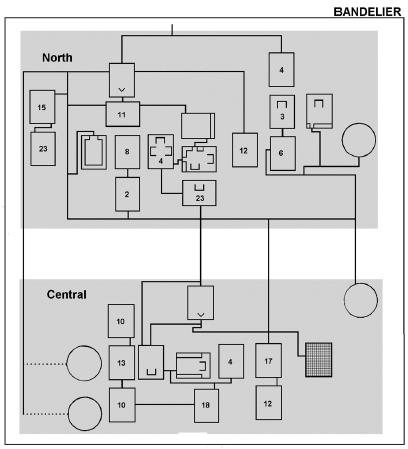
For comparative purposes, I have included information on two more poorly preserved palaces, Gran Chimú and Velarde. Gran Chimú dates to the end of the Middle phase, while Velarde dates to the beginning of the Late phase. While the information for these two palaces is not as complete as for the rest of the sample, they are not inconsistent with the pattern observed.
As already mentioned, early storerooms are often located near the U-shaped structures, while the late storerooms are often isolated from the U-shaped structures. This pattern is also related to another pattern: the late palaces are divided into a northern and a central sector (Figure 6.6; see also Figures 6.11–6.13). In the last four palaces (Table 6.1) there are always proportionately more U-shaped structures and fewer storerooms in the northern sector and proportionately fewer U-shaped structures and more storerooms in the central sector (Moseley 1975a). This has been interpreted to reflect the differential flow of goods into and out of the palaces, with longer-term storage in the central sector and a higher turnover of goods in the northern sector (i.e., Topic 2003); the higher turnover would require more accountancy and hence the larger number of U-shaped structures.
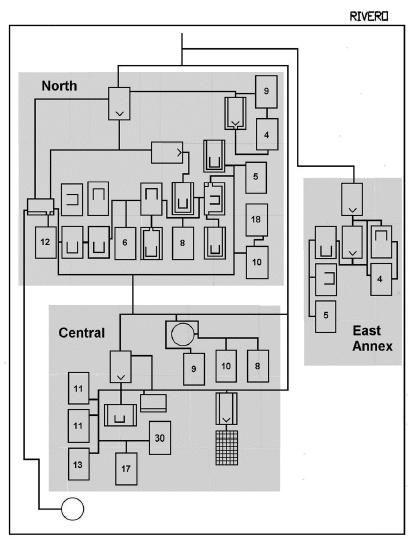
Figure 6.12 Diagram of the Rivero palace. From Topic (2003).
Table 6.3 Storage in the Last Three Palaces by Sector
| Palace | North | Central | East | South |
| Bandelier | ||||
| Courts | 11 | 7 | --- | --- |
| Rooms | 111 | 84 | --- | --- |
| Average # of rooms/court | 10 | 12 | --- | --- |
| Courts with fewer than twelve rooms | 73% | 57% | --- | --- |
| Bandelier | ||||
| Courts | 8 | 8 | 2 | --- |
| Rooms | 72 | 109 | 9 | --- |
| Average # of rooms/court | 9 | 13.6 | 4.5 | --- |
| Courts with fewer than twelve rooms | 88% | 62% | 100% | --- |
| Bandelier | ||||
| Courts | 13 | 7 | 3 | 1 |
| Rooms | 104 | 80 | 69 | 8 |
| Average # of rooms/court | 8 | 11.4 | 23 | 8 |
| Courts with fewer than twelve rooms | 92% | 57% | 67% | 100% |
Figures 6.11–6.13 illustrate the last three well-preserved palaces in diagrammatic format. Bandelier is divided into two clear sectors; Rivero has a northern and central sector as well as a well-defined eastern sector; Tschudi seems to have a northern, central, and eastern sector, plus an isolated storage court in the south. Table 6.3 summarizes some information about the courts and the storerooms. In the north sectors, where there would be a higher turnover of goods, we see a higher percentage of courtyards with twelve or fewer storerooms than we find in the central sectors. The average number of storerooms per court is also consistently slightly smaller in the north sectors than in the central sectors. The eastern sectors and the one southern sector are idiosyncratic. In general, though, the comparison between the northern and central sectors seems to reinforce the interpretation that smaller units of storage were employed as accounting systems became more sophisticated at Chan Chan.
Figure 6.13 Diagram of the Tschudi palace. From Topic (2003).
Conclusion
Andean accounting systems use tokens put into places that represent the categories of things being counted. Here I have explored that dimension of place, positioning, or location as it pertains to a number of distinct situations, with a special focus on how the arrangement of storerooms may contribute to the keeping of records.
Both Inka and Chimú storerooms tend to be relatively standardized in size, at least within particular complexes. However, I think that the packaging of the things stored, whether in bales, jars, or sacks may have been as important to the record keeping as the size of the storeroom itself. Both Morris (1992b) at Huánuco and Topic and Chiswell (1992) at Huamachuco describe facilities that may have been used to sort, measure, and package materials before storage.
Storeroom shape was probably another “qualifier” that aided in keeping account of materials stored, but it may have been applied differently in different situations. For Huamachuco, for example, the ventilation and drainage features were more important than shape itself. The presence of just a single shape at Cotapachi and at Chan Chan (although these varied in dimensions) would not have helped to differentiate the contents of one room from another.
The distribution of storerooms was certainly another element in the record-keeping system. We have seen how at Cotapachi there were only two main groupings of buildings, at Huamachuco five, at Huánuco eleven rows, and in Jauja fifty-three distinct sites. These groupings must have meant something to the people charged with keeping track of the materials stored, but as with some of the qualifiers applied to quipu, we may never know what information was being conveyed.
The same applies to the groupings of storerooms within storage courts at Chan Chan. There, however, the limited amount of patterning that was discussed in this chapter does seem to correlate with the development of bureaucracy at the site (Topic 2003), as well as with some Andean numerical concepts.
References
Acosta, Joseph de. 1940 [1590]. Historia natural y moral de las Indias. Edición de EdmundoO’Gorman, Biblioteca Americana. Mexico City: Fondo de Cultura Económica.
Andrews, Anthony P. 1974. The U-Shaped Structures at Chan Chan, Peru. Journal ofField Archaeology 1: 241–264.
Ascher, Marcia. 1990. El sistema lógico-numérico de los quipus. In Quipu y yupana: Colección de escritos, ed. C. Mackey, H. Pereyra, C. Radicati, H. Rodríguez, and O. Valverde, 109–124. Lima: Consejo Nacional de Ciencia y Tecnologia. Ministerio de la Presidencia.
Ascher, Martha, and Robert Ascher. 1981. The Code of the Quipu: A Study in Media, Mathematics, and Culture.Ann Arbor: University of Michigan Press.
Bergh, Sue. 1999. Pattern and Paradigm in Middle Horizon Tapestry Tunics. PhD dissertation. University Microfilms.
Boone, Elizabeth Hill. 1994. Introduction: Writing and Recording Knowledge. In Writing without Words: Alternative Literacies in Mesoamerica and the Andes, ed. E. H. Boone and W. D. Mignolo, 3–26. Durham, NC: Duke University Press.
Byrne de Caballero, Geraldine. 1973. Los Misteriosos Círculos de Cotapachi. Los Tiempos, March 11, 1973, Cochabamba.
Byrne de Caballero, Geraldine. 1975. La arquitectura de almacenamiento en la logística incaica. El Diario, November 30, 1975, La Paz.
Calancha, Antonio de la. 1974–82 [1638]. Crónica moralizada del orden de San Agustín en el Perú. Transcripción, estudio crítico, notas bibliográficas e índices de Ignacio Prado Pastor, 6 vols. Lima: Imprenta de la Universidad Nacional Mayor de San Marcos.
Cieza de León, Pedro. 1985 [1553]. Crónica del Perú: Segunda parte. Segunda edición de 1986. Colección Clásicos Peruanos. Lima: Pontificia Universidad Católica del Perú Academia Nacional de la Historia.
Conklin, William J. 1982. The Information System of Middle Horizon Quipus. In Ethnoastronomy and Archaeoastronomy in the American Tropics, ed. A. R. Aveni and G. Urton, 261–281. New York: New York Academy of Sciences.
D’Altroy, Terence N., and Timothy K. Earle. 1992. Inka Storage Facilities in the Upper Mantaro Valley, Peru. In Inka Storage Systems, ed. T. Y. LeVine, 176–205. Norman: University of Oklahoma Press.
D’Altroy, Terence N., and Christine A. Hastorf. 1992. The Architecture and the Contents of Inka State Storehouses in the Xauxa Region of Peru. In Inka Storage Systems,ed. T. Y. LeVine, 259–286. Norman: University of Oklahoma Press.
Day, Kent C. 1982a. Ciudadelas: Their Form and Function. In Chan Chan: Andean Desert City, ed. M. E. Moseley and K. C. Day, 55–66. Albuquerque: School of American Research and University of New Mexico Press.
Day, Kent C. 1982b. Storage and Labor Service: A Production and Management Design for the Andean Area. In Chan Chan: Andean Desert City, ed. M. E. Moseley and K. C. Day, 333–349. Albuquerque: School of American Research.
Donnan, Christopher B. 1971. Ancient Peruvian Potters’ Marks and Their Interpretation through Ethnographic Analogy. American Antiquity 36 (4): 460–466.
Donnan, Christopher B. 2009. The Moche Use of Numbers and Number Sets. In Andean Civilization: A Tribute to Michael E. Moseley, ed. J. Marcus and P. R. Williams, 165–180. Los Angeles: Cotsen Institute of Archaeology.
Earle, Timothy K. 1992. Storage and the Inka Imperial Economy: Archaeological Research. In Inka Storage Systems, ed. T. Y. LeVine, 327–342. Norman: University of Oklahoma Press.
Jackson, Margaret A. 2002. Proto-Writing in Moche Pottery at Cerro Mayal, Peru.In Andean Archaeology II: Art, Landscape, and Society, ed. H. S. and W. H. Isbell, 107–135. New York: Kluwer Academic/Plenum Publishers.
Larco Hoyle, Rafael. 1942. La Escritura Peruana Sobre Pallares. Revista Geográfica Americana (Buenos Aires) 18: 93–105.
Larco Hoyle, Rafael. 1943. La Escritura Peruana Sobre Pallares. Revista Geográf ca Americana (Buenos Aires) 20: 345–354.
Larco Hoyle, Rafael. 2001. Los Mochicas. 2 vols. Lima: Museo Arqueológico Rafael Larco Herrera.
LeVine, Terry Y. 1992a. Inka State Storage in Three Highland Regions: A Comparative Study. In Inka Storage Systems, ed. T. Y. LeVine, 107–148. Norman: University of Oklahoma Press.
LeVine, Terry Y. 1992b. The Study of Storage Systems. In Inka Storage Systems, ed. T. Y. LeVine, 3–28. Norman: University of Oklahoma Press.
Locke, Leland L. 1923. The Ancient Quipu or Peruvian Knot Record. New York: American Museum of Natural History.
Mackey, Carol J. 1970. Knot Records in Ancient and Modern Peru. PhD dissertation. Berkeley, University of California.
Mackey, Carol, Hugo Pereyra, Carlos Radicati, Humberto Rodríguez, and Óscar Valverde, eds. 1990. Quipu y yupana: Colección de escritos. Lima: Consejo Nacional de Ciencia y Tecnología. Ministerio de la Presidencia.
Mignolo, Walter D. 1994. Signs and Their Transmission: The Question of the Book in the New World. In Writing without Words: Alternative Literacies in Mesoamerica and the Andes, ed. E. H. Boone and W. D. Mignolo, 220–270. Durham, NC: Duke University Press.
Moore, Jerry D. 1992. Pattern and Meaning in Prehistoric Peruvian Architecture: The Architecture of Social Control in the Chimu State. Latin American Antiquity 3 (2): 95–113.
Morris, Craig. 1967. Storage in Tahuantinsuyu. PhD dissertation. University of Chicago.
Morris, Craig. 1992a. Foreword. In Inka Storage Systems, ed. T. Y. LeVine, ix–xiii. Norman: University of Oklahoma Press.
Morris, Craig. 1992b. Huánuco Pampa and Tunsukancha: Major and Minor Nodes in the Inka Storage Network. In Inka Storage Systems, ed. T. Y. LeVine, 151–175. Norman: University of Oklahoma Press.
Morris, Craig. 1992c. The Technology of Highland Inka Storage. In Inka Storage Systems, ed. T. Y. LeVine, 237–258. Norman: University of Oklahoma.
Moseley, Michael E. 1975a. Chan Chan: Andean Alternative of the Preindustrial City? Science 187: 219–225.
Moseley, Michael E. 1975b. Prehistoric Principles of Labor Organization in the Moche Valley, Peru. American Antiquity 40 (2): 191–196.
Moseley, Michael Edward, and Carol J. Mackey. 1974. Twenty-Four Architectural Plans of Chan Chan, Peru. Cambridge: Peabody Museum Press.
Murra, John V. 1975. Las etno-categorías de un khipu estatal. In Formaciones económicas y políticas del mundo andino, ed. J. V. Murra, 243–254. Lima: Instituto de Estudios Peruanos, Historia Andina 3.
Murra, John V. 1982. The Mit’a Obligations of Ethnic Groups to the Inka State. In The Inca and Aztec States, 1400–1800: Anthropology and History, ed. G. A. Collier, R. I. Rosaldo, and J. D. Wirth, 238–262. New York: Academic Press.
Núñez del, Prado, Óscar. 1990. El Kipu moderno. In Quipu y yupana: Colección de escritos, ed. C. Mackey, H. Pereyra, C. Radicate, H. Rodríguez, and O. Valverde, 165–182. Lima: Consejo Nacional de Ciencia y Tecnología.
Pereyra-Sánchez, Hugo. 1990. La yupana, complemento operacional del quipu. In Quipu y yupana: Colección de escritos, ed. C. Mackey, H. Pereyra, C. Radicati, H. Rodríguez, and O. Valverde, 235–255. Lima: Consejo Nacional de Ciencia y Tecnología, Ministerio de la Presidencia.
Pereyra-Sánchez, Hugo. 1997. Los quipus con cuerdas entorchadas. In Arqueología, antropología e historia en los Andes: Homenaje a María Rostworowski, ed. R. Varón Gabai and J. Flores Espinoza, 187–197. Lima: Instituto de Estudios Peruanos y Banco Central de Reserva del Perú.
Poma de Ayala, Felipe Guaman. 1980 [1615]. El primer nueva corónica i buen gobierno. Ed. John V. Murra and Rolena Adorno. Mexico City: Siglo Veintiuno editores.
Radicati di Primeglio, Carlos. 1979. El sistema contable de los Incas: Yupana y quipu. Lima: Librería Studium.
Radicati di Primeglio, Carlos. 1990. El cromatismo de los quipus. Significado del quipu de canutos. In Quipu y yupana: colección de escritos, ed. C. Mackey, H. Pereyra, C. Radicati, H. Rodríguez, and O. Valverde, 39–50. Lima: Consejo Nacional de Ciencia y Tecnología, Ministerio de la Presidencia.
Snead, James E. 1992. Imperial Infrastructure and the Inka State Storage System. In Inka Storage Systems, ed. T. Y. LeVine, 62–106. Norman: University of Oklahoma Press.
Topic, John R. 1990. Craft Production and the Kingdom of Chimor. In The Northern Dynasties: Kingship and Statecraf in Chimor, ed. M. E. Moseley and A. Cordy-Collins, 145–176. Washington, DC: Dumbarton Oaks Research Library and Collection.
Topic, John R. 2003. From Stewards to Bureaucrats: Architecture and Information Flow at Chan Chan, Peru. Latin American Antiquity 14 (3): 243–274.
Topic, John R. 2009. Domestic Economy as Political Economy at Chan Chan, Peru. In Domestic Life in Prehispanic Capitals: A Study of Specialization, Hierarchy, and Ethnicity, ed. L. R. Manzanilla and C. Chapdelaine, 221–242. Ann Arbor: Museum of Anthropology, University of Michigan.
Topic, John R., and Coreen E. Chiswell. 1992. Inka Storage in Huamachuco. In InkaStorage Systems, ed. T. Y. LeVine, 206–233. Norman: University of Oklahoma Press.
Topic, John R., and Michael E. Moseley. 1985. Chan Chan: A Case Study of Urban Change in Peru. Ñawpa Pacha 21 (1983): 153–182.
Urton, Gary. 1997. The Social Life of Numbers: A Quechua Ontology of Numbers and Philosophy of Arithmetic. Austin: University of Texas Press.
Urton, Gary. 2001. A Calendrical and Demographic Tomb Text from Northern Peru. Latin American Antiquity 12 (2): 127–147.
Vega, Inca Garcilaso de la . 1966 [1609 and 1617]. Royal Commentaries of the Incas and General History of Peru. Trans. H. V. Livermore. Austin: University of Texas Press.
Wachtel, Nathan. 1982. The Mitimas of the Cochabamba Valley: The Colonization Policy of Huayna Capac. In The Inca and Aztec States, 1500–1800: Anthropology and History, ed. G. A. Collier, R. I. Rosaldo, and J. D. Wirth, 199–235. New York: Academic Press.
Wassén, Henry. 1990. El antíguo ábaco peruano según el manuscrito de Guaman Poma. In Quipu y yupana: Colección de escritos, ed. C. Mackey, H. Pereyra, C. Radicati, H. Rodríguez, and O. Valverde, 205–218. Lima: Consejo Nacional de Ciencia y Tecnología, Ministerio de la Presidencia.
Weber, Max. 1946. Bureaucracy. In From Max Weber: Essays in Sociology, ed. H. H. Gerth and C. W. Mills, 196–244. New York: Oxford University Press.
